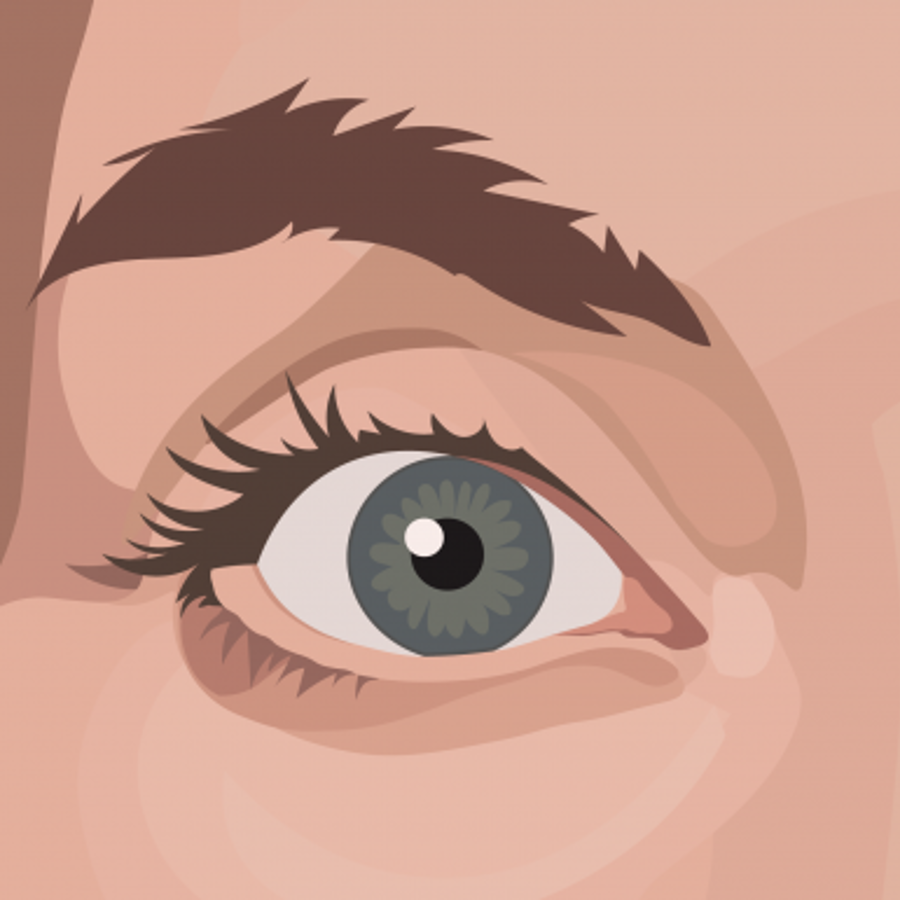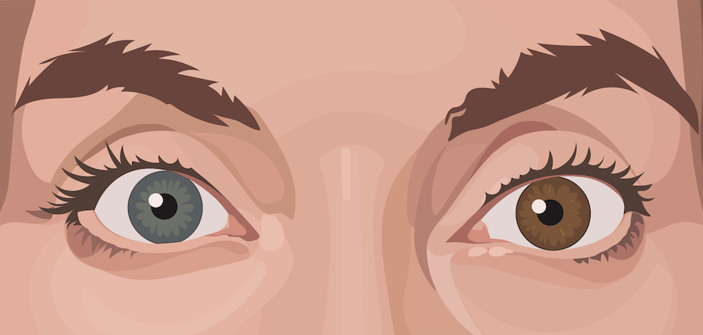
What could cause one eye to change color?
June 18, 2004

- Related Topics:
- Heterochromia,
- Eye color,
- Mosaicism,
- Chimera,
- Pigmentation traits
A curious adult from Colorado asks:
"My eleven year old daughter was born with blue eyes. When she was about five months old one eye began to turn brown but the other one stayed blue. She now has one predominately blue eye with a touch of brown in one area and a predominately brown eye with a couple of little blue swirls. I have always been curious about what caused this."
Having two different colored eyes (heterochromia) is rare but not unheard of in humans (and is pretty common in some animals, such as some breeds of dogs). In fact, some famous people like David Bowie*, Kiefer Sutherland and Christopher Walken have different colored eyes.
Where does it come from? To understand this, first let's understand what eye color is. Eye color comes from a pigment called melanin; blue eyes have no melanin and brown eyes have lots of melanin in a part of the eye called the stroma. When babies are first born they usually have blue eyes. Light stimulates the eye to make melanin so that usually by age 3, a person has their final eye color.
So it isn't that unusual that your daughter was born with blue eyes that changed to brown at 5 months. What is unusual is that only one of her eyes changed like they did. There are a number of ways to get two different colored eyes.
One well-documented possibility for changing one eye to a different color is some sort of trauma to that eye. If the trauma happened in the womb, this could be the explanation even if nothing obvious happened as a baby.
Other reasons are a little harder to explain. As you know, genes are an important part of determining eye color. Eye color is pretty complex and there are lots of genes involved.
So one way to get two different colored eyes is to have each eye have different genes. How is this possible? I can think of three ways this could happen off the top of my head.
First, it is possible that very early in the pregnancy, one cell of the developing fetus had a change or mutation in an eye color gene. As the fetus developed, that cell gave rise to parts of the body that included one eye while the "normal" cells developed the other eye. This condition is called somatic mosaicism.
Another possibility is that two fertilized eggs fused together to form a single person (kind of like the reverse of twins). This is called chimerism. The difference between this and somatic mosaicism is that in chimerism, lots of genes are different instead of just the one. This is a very unlikely scenario, though.
Finally, for genes to work, they must be turned on or expressed. There are well known cases where a gene is turned on in one cell and turned off in another part of the body. A classic example is X inactivation, where half of the cells in the body turn off one X chromosome and the other half turn off the other. In this scenario, the pigment gene is shut off in one eye and is on in the other.

All 3 possibilities could also help explain the pattern of eye color in each eye. If various cells of the eye make different amounts of melanin, then you might get a "brown eye with a couple of swirls."
Well, this is probably WAY more than you wanted to know. Since there are some strains of dogs in which two different colored eyes, there may be a more conventional genetic explanation that we just don't know about right now. Hopefully, some scientist somewhere will study these dogs, find the responsible gene(s), and see if humans can get two different colored eyes the same way.
*Editor’s note (5/4/2021): Contrary to what’s stated in this article, David Bowie’s eyes are not actually two different colors. One eye only appears darker because of a permanently enlarged pupil.

Author: Dr. Barry Starr
Barry served as The Tech Geneticist from 2002-2018. He founded Ask-a-Geneticist, answered thousands of questions submitted by people from all around the world, and oversaw and edited all articles published during his tenure. AAG is part of the Stanford at The Tech program, which brings Stanford scientists to The Tech to answer questions for this site, as well as to run science activities with visitors at The Tech Interactive in downtown San Jose.
 Skip Navigation
Skip Navigation
